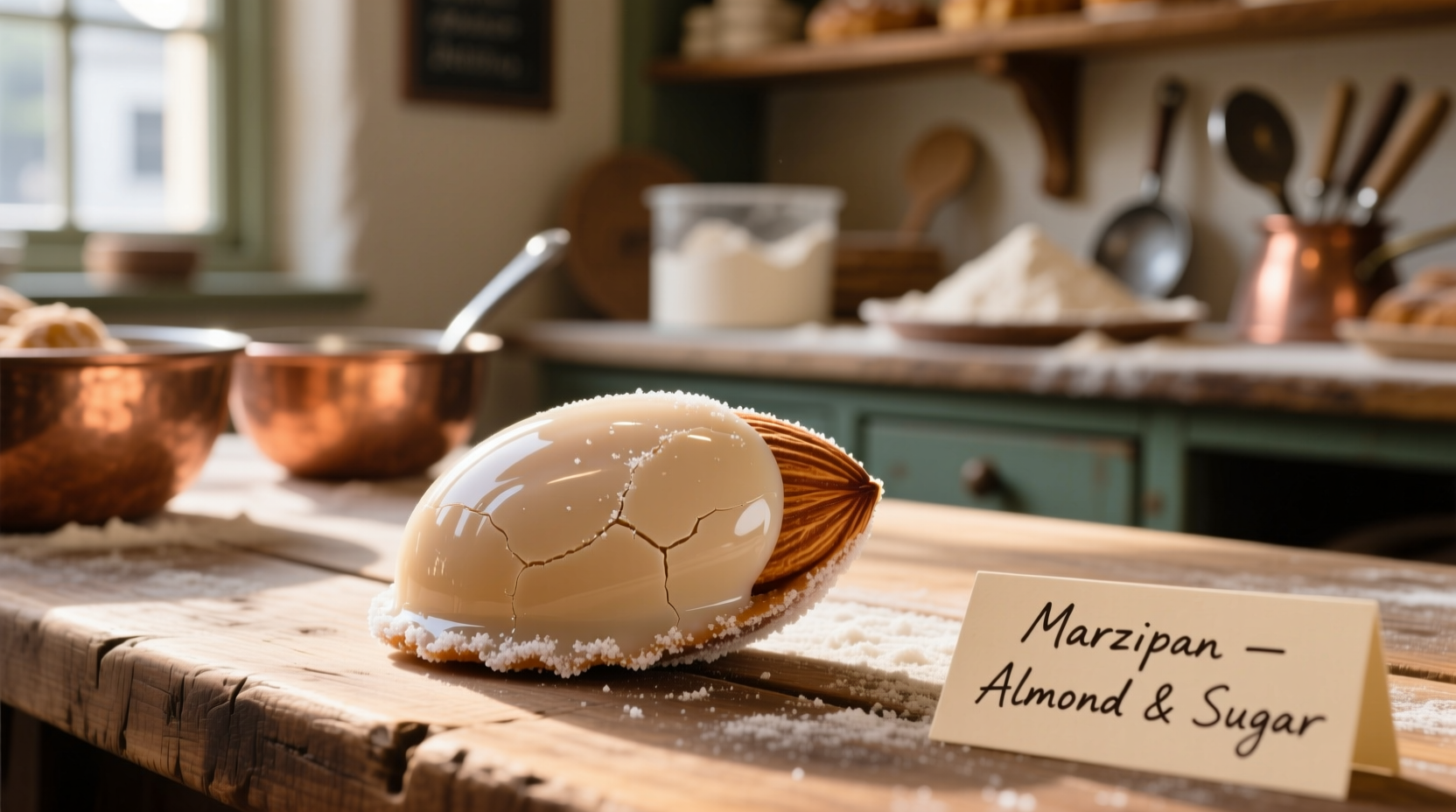As a French-trained chef who's worked with marzipan across European pastry traditions for over 15 years, I've developed a refined palate for this beloved confection. Whether you're encountering marzipan for the first time or seeking to deepen your understanding, this guide delivers precise sensory details you won't find elsewhere.
The Complete Sensory Profile of Marzipan
Marzipan isn't just “sweet almond”—its flavor profile reveals sophisticated layers when examined closely. Authentic marzipan creates a distinctive sensory experience that varies based on quality and origin.
Flavor Breakdown: Beyond Basic Sweetness
At its core, marzipan delivers a pronounced sweet almond flavor derived from ground almonds and sugar. But the experience goes deeper:
- Nutty foundation – A rich, toasted almond essence forms the base note
- Floral undertones – High-quality marzipan reveals subtle hints of cherry blossom or bitter almond blossom
- Citrus whisper – Many European varieties include a trace of orange flower water that brightens the profile
- Vanilla warmth – Premium versions often incorporate real vanilla to round out sharp edges
The sugar content (typically 25-40%) balances the nuttiness without overwhelming it. Unlike artificial almond extracts that taste medicinal, genuine marzipan maintains a natural almond character thanks to benzaldehyde—the same compound found in fresh almonds.

Texture: The Critical Component
Texture dramatically impacts marzipan's perceived flavor. Traditional European marzipan features a smooth, pliable consistency that yields gently when pressed. The finest varieties melt almost instantly at body temperature, releasing flavor gradually.
Lower-quality versions often feel:
- Grainy (insufficient almond grinding)
- Sticky (excess sugar syrup)
- Chalky (too much powdered sugar)
Marzipan vs. Similar Confections: Clearing the Confusion
Many confuse marzipan with related products. Understanding these differences helps set accurate taste expectations.
| Product | Sugar-to-Almond Ratio | Texture | Primary Use | Taste Profile |
|---|---|---|---|---|
| Marzipan | 2:1 or 3:1 | Smooth, moldable | Decorative modeling | Sweet almond with floral notes |
| Almond Paste | 1:1 or 1:2 | Dense, crumbly | Baking ingredient | Stronger almond, less sweet |
| Frangipane | Variable | Creamy | Filling for pastries | Buttery almond custard |
This comparison explains why marzipan tastes sweeter and more delicate than almond paste—its higher sugar content creates a different sensory experience despite similar ingredients.
Factors That Transform Marzipan's Flavor
Marzipan isn't monolithic. Several elements create significant taste variations you should understand before purchasing or using it.
Regional Differences in Marzipan Taste
European marzipan traditions yield distinctive flavor profiles:
- German Lübeck style – Contains 60% almonds with minimal sugar, delivering intense nuttiness (protected EU geographical indication)
- Spanish mazapán – Often includes egg whites and citrus, creating a lighter, airier texture with brighter flavor
- British marchpane – Historically contained rosewater, though modern versions favor orange flower water
- American “almond candy” – Typically uses almond extract rather than real almonds, resulting in artificial flavor
The European Food Safety Authority confirms that authentic marzipan must contain at least 50% almonds by weight to qualify for the name, directly impacting flavor authenticity (EFSA Journal 2016;14(10):4600).
Quality Indicators That Affect Taste
When selecting marzipan, watch for these quality markers that determine flavor:
- Almond type – Sweet almonds (Prunus dulcis) provide authentic flavor; bitter almonds contain toxic compounds and aren't used in commercial production
- Grinding fineness – Professional mills produce particles under 50 microns for smooth texture
- Sugar quality – Confectioners' sugar with cornstarch affects mouthfeel and sweetness perception
- Resting time – Premium marzipan rests 48+ hours for flavors to meld properly
Practical Guidance for Using Marzipan
Understanding marzipan's flavor helps you use it effectively in culinary applications.
Best Culinary Applications by Flavor Profile
Marzipan's sweet almond character shines in specific contexts:
- As standalone confection – Enjoy small pieces at room temperature to appreciate full flavor development
- With dark chocolate – The bitterness balances marzipan's sweetness (try 70% cacao or higher)
- In fruit pairings – Complements tart cherries, apricots, and citrus
- As cake decoration – Traditional on Christmas cakes where it slowly permeates flavor
Avoid heating marzipan above 140°F (60°C), as this causes the delicate almond compounds to evaporate, leaving only sweetness.
Storage Tips to Preserve Flavor
Marzipan's flavor degrades when improperly stored:
- Keep wrapped in wax paper, not plastic (traps moisture causing stickiness)
- Store at 60-65°F (15-18°C)—refrigeration dulls flavor perception
- Consume within 3 weeks for peak flavor (commercial versions last longer due to preservatives)
Common Misconceptions About Marzipan Flavor
Several myths persist about marzipan's taste that deserve clarification.
“Marzipan tastes like fake almond extract”
This misconception arises from low-quality products using artificial flavoring. Authentic marzipan made with real almonds contains natural benzaldehyde—the same compound responsible for fresh almond flavor. The University of California's Department of Food Science confirms (UC ANR Almond Research) that properly made marzipan delivers a pure almond experience indistinguishable from fresh almonds to trained palates.
“All marzipan tastes the same”
Quality variations create dramatic flavor differences. Artisan marzipan made with Marcona almonds offers buttery notes absent in versions using common almond varieties. The sugar-to-almond ratio (anywhere from 1:1 to 3:1) dramatically impacts sweetness perception.
First-Time User Recommendations
If you've never tasted marzipan, follow these steps for the optimal experience:
- Choose European-style marzipan with at least 50% almonds (check ingredient list)
- Bring to room temperature for 30 minutes before sampling
- Start with a small piece (about 1-inch cube)
- Let it rest on your tongue without chewing to experience texture melting
- Notice flavor progression: initial sweetness, then almond richness, finally subtle floral notes
For beginners, I recommend trying traditional German Lübecker Marzipan—its higher almond content delivers the purest expression of marzipan's distinctive flavor profile.
Frequently Asked Questions
Is marzipan supposed to taste bitter?
No, authentic marzipan should not taste bitter. Bitterness indicates either poor-quality almonds, improper processing, or the use of bitter almond extract which contains toxic compounds. Genuine marzipan made from sweet almonds delivers a smooth, nutty sweetness without harsh notes.
Why does some marzipan taste like cherry?
The cherry-like note comes from benzaldehyde, the natural compound in sweet almonds that provides marzipan's characteristic flavor. This same compound gives cherries their distinctive aroma, creating a subtle cherry undertone in high-quality marzipan made with real almonds rather than artificial flavoring.
How can I tell if marzipan has gone bad?
Spoiled marzipan develops a rancid, oily smell and may show discoloration. The texture becomes excessively hard or sticky. Fresh marzipan maintains a consistent pale ivory color and yields gently when pressed. Properly stored, it should retain its sweet almond aroma without any sour or stale notes.
Does marzipan taste different when used in baking?
Yes, heating marzipan above 140°F (60°C) causes the delicate almond compounds to evaporate, leaving primarily sweetness. When baked into cakes or pastries, it contributes moisture and subtle background flavor rather than the pronounced almond taste experienced when eaten fresh. For maximum flavor impact, use marzipan as a filling or topping added after baking.











 浙公网安备
33010002000092号
浙公网安备
33010002000092号 浙B2-20120091-4
浙B2-20120091-4